4.2 Mein Lieblingsmensch und ich

Hallo alle zusammen!
Zum Aufwärmen machen wir unseren Tagesminiplausch und eine Wiederholung.
Wiederholung
In the previous lesson you learned to talk about how long you’ve know your best friend (or any person) and to explain from where you know that person. You also learned the questions that lead to this type of information. Let’s review.
|
|
Max & Meike |
Wie lange kennst du schon deina besta Freund*in? Woher kennst du xien? Answer the questions in your written journal.
Lektionsüberblick
Learning about someone’s friends can tell you a lot about that person. As you get to know people in Germany, you can talk about your friends back home. Although the adage says “Gegensätze ziehen sich an” (opposites), you will likely have more in common with your best friend than not. In this lesson, you will talk about your best friend, your favorite person, in comparison to yourself. In the end, you will be able to 1) ask someone to describe their best friend, 2) describe your best friend’s physical appearance, 3) describe your best friend’s personality, and 4) compare your best friend to yourself.
Was weißt du schon?
Read and listen to Yasmin’s description of her best friend. Then, practice reading the description aloud yourself.
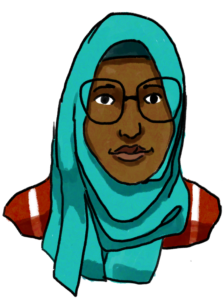 |
Mein bester Freund heißt Timo. Er ist 23 Jahre alt und studiert Literatur. Er wohnt in München. Er ist klein und hat blonde Haare. Seine Augen sind braun. Timo ist sehr intelligent. Ich finde Timo auch sympathisch und freundlich. |
| Noch nicht start klar?
Du kannst immer auf die gleiche 1010-Lektion zurückgreifen! |
Not confident about starting this lesson?
You can always review the same Lektion from 1010. |
1) How to ask someone to describe their friend
An important part of communication in many cultures is asking questions. How would you ask another to describe their friend or favorite person (personality and/or appearance)?
Listen to how to ask this question:
|
Wie ist dein bester Freund? |
Wie sieht dein bester Freund aus? |
Practice repeating the questions.
You can also shorten the questions by using er/sie/xier as you have learned previously. Listen to the audio and read along with the comic below and answer the questions that follow. Be sure to click through to each question.
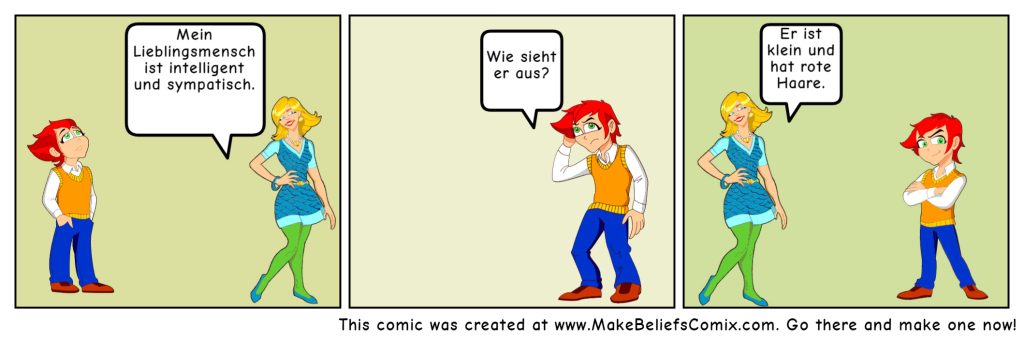
Frankfurt am Main im Blickpunkt

Die Europäische Zentralbank (EZB) steht in Frankfurt am Main im Stadtteil Ostend. Sie hat zwei hohe Türme, den Nordturm mit 185m und den Südturm mit 165m. In der EZB arbeiten ungefähr 2.300 Menschen. Die Deutsche Bundesbank, die nationale Zentralbank von Deutschland, hat ebenfalls ihren Sitz in Frankfurt. Beide Banken sind wichtig für die Stabilität des europäischen Geldsystems.
The European Central Bank (ECB) is located in the Ostend district of Frankfurt am Main. It has two tall towers, the North Tower and the South Tower, which together are 201 meters high. Approximately 2,300 people work at the ECB. The Deutsche Bundesbank, Germany’s national central bank, is also headquartered in Frankfurt. Both banks are important for the stability of the European monetary system.
Jetzt bist du dran!
2) Wie mein Lieblingsmensch aussieht
You recall physical descriptions from our previous lessons. Here are some examples.
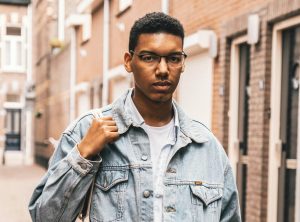
Mein bester Freund hat kurze Haare. |

Meine beste Freundin hat sehr lange Haare.
|
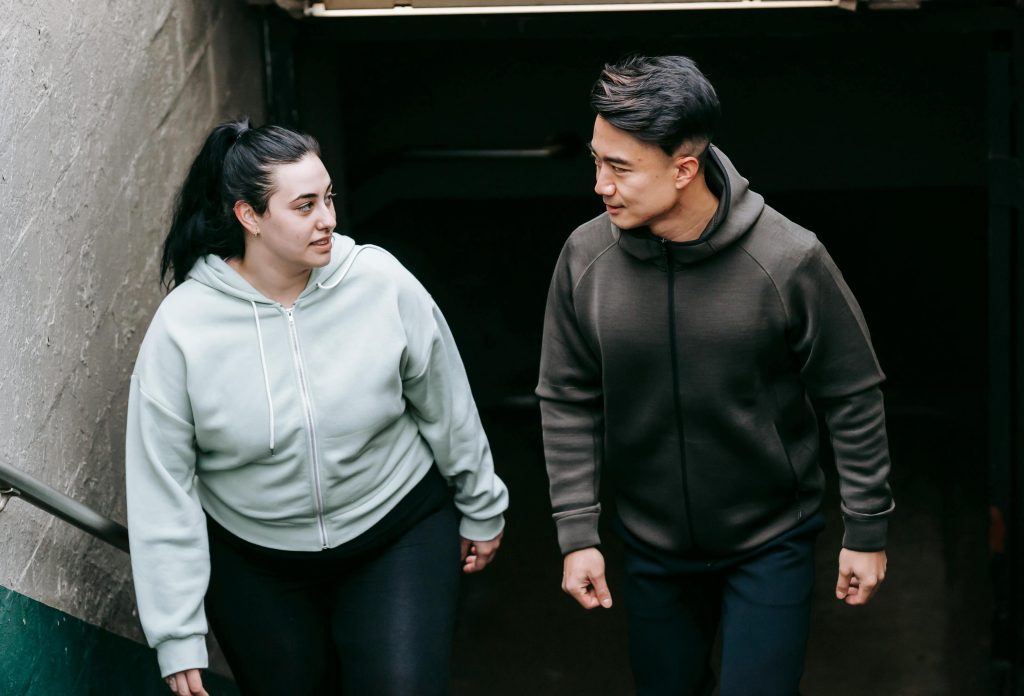
Meina besta Freund*in ist groß und sehr attraktiv. |

Meine beste Freundin hat große braune Augen. |
Jetzt bist du dran!
3) Wie mein Lieblingsmensch ist
Let’s look at ways to describe our best friend. The sentences on the left and right are options. Which way do you like better?
| Mein bester Freund ist intelligent. | Mein bester Freund ist ein intelligenter Mensch. |
| Meine beste Freundin ist sportlich. | Meine beste Freundin ist eine sportliche Person. |
| Meina besta Freun*in ist lustig. | Meina besta Freun*in ist ein lustiger Mensch. |
| Mein bester Freund ist sympatisch. | Mein bester Freund ist eine sympatische Person. |
Let’s practice using the comic below. Be sure to click through to each question.
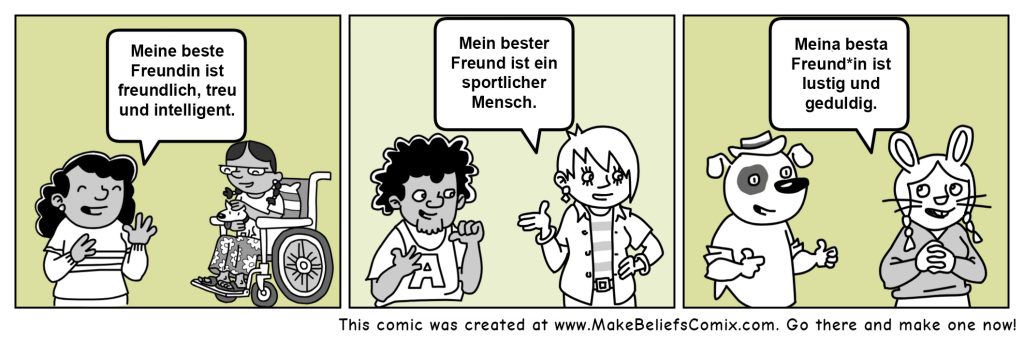
Jetzt bist du dran!
4) Ein Vergleich
It’s human to make comparisons. Not to mention, you already have some experience making comparisons in German. Think: Ich bin älter als mein Bruder. Read the comparisons in the comic below.
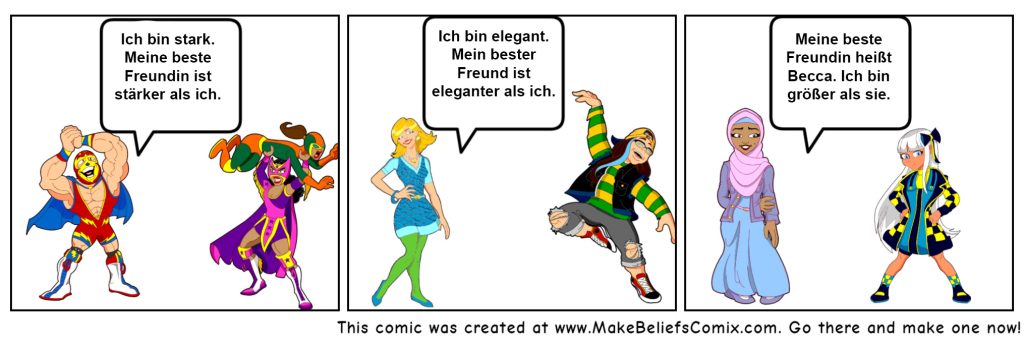 |
||
Jetzt bist du dran!
Zum Schluß
In this lesson, you learned to 1) ask someone to describe their best friend, 2) describe your best friend’s physical appearance, 3) describe your best friend’s personality, and 4) compare your best friend to yourself. If you are feeling unsure about any part, please go back to that section and review.
Let’s combine it all! Choose a friend that you are close to. If you have a Lieblingsmensch, that is wonderful, but any friend is important. Write a short description of your friend, including their name, where they live, how old they are, and a description of their personality and appearance. Then using what you wrote in the previous exercise as a guide, compare yourself to your friend. You may compare physical attributes or personality attributes. Feeling adventurous? Then include additional descriptors such as etwas/ein bisshen/sehr/gar nicht, etc. Have fun building your description and remember that it’s okay to make mistakes. Mistakes are a necessary part of language learning.

*As you conclude this lesson, don’t forget to check Canvas!*

Media Attributions
- Yasmin image and text adapted from Grenzenlos Deutsch, licensed under a CC BY-NC-SA 4.0 International License.
Media Attributions
- Image of Max from Grenzenlos Deutsch, GD Max.pgn_-211×300, licensed under a Creative Commons Attribution-NonCommercial-ShareAlike 4.0 International License.
- Vector of Meike by Gear Digital Arts at vecteezy_image-of-a-girl-wearing-glasses_22968253, Attribution required per site
- 4.2 comic make-beliefs-comix-16-2048×684 © This comic strip was generated at http://www.MakeBeliefsComix.com. Used by permission of author and site creator Bill Zimmerman.
- Photo of “Europäische Zentralbank (EZB)” by Kiefer, CC BY-SA 2.0
- 3.4 alex und Julia_pexels-andres-ayrton-6551222 © Andres Ayrton is licensed under a CC0 (Creative Commons Zero) license
- Photo of woman from pexels-enginakyurt-3168965
- 4.2 comic wie mein bester freund ist file-66f998ff65889 © This comic strip was generated at http://www.MakeBeliefsComix.com. Used by permission of author and site creator Bill Zimmerman.
- 4.2 comic vergleich make-beliefs-comix-19-2048×684 © This comic strip was generated at http://www.MakeBeliefsComix.com. Used by permission of author and site creator Bill Zimmerman.



